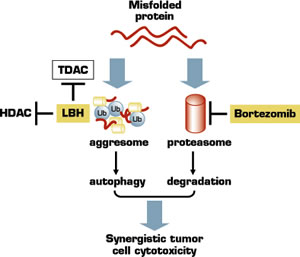The ubiquitin proteasome pathway is a major system for degradation of proteins, and the proteasome inhibitor, Bortezomib, has now been FDA-approved for treatment of relapsed as well as relapsed and refractory multiple myeloma. In spite of its remarkable activity, some patients do not respond, and those who do respond eventually acquire resistance. Moreover, clinical activity outside of myeloma has been limited. We are now beginning to uncover clues to address this problem. Specifically, an alternative mechanism for degradation of ubiquinated proteins is via the aggresome/lysosome/autophagy pathway1 . In this cascade, histone deacetylase (HDAC) 6 binds to ubiquinated protein on the one hand, and to dynein microtubule complexes on the other, thereby shuttling the ubiquinated protein to its degradation via the aggresome/lysosome/-autophagy mechanism. The relative roles of these two pathways of protein degradation, both in normal and cancer cells, as well as their substrate specificities, are not yet defined. Previous studies in myeloma have shown that blockade of the aggresome cascade with tubulin deacetylase inhibitor tubacin triggers a compensatory increase in proteasomal degradation of ubiquinated proteins, whereas inhibition of proteasomal degradation of ubiquinated proteins with Bortezomib induces increased aggresomal activity2 . Importantly, inhibiting both aggresomal and proteasomal activity with tubacin and Bortezomib, respectively, triggers synergistic myeloma cell cytotoxicity, associated with significant accumulation of polyubiquinated proteins.
In this study, Catley and colleagues move this concept from bench to bedside towards a derived clinical trial. They show that the novel hydroxamic acid derivative histone deacetylase inhibitor LBH 589 induces apoptosis of myeloma cells resistant to conventional and novel therapies, as well as tubulin hyperacetylation, at clinically achievable concentrations. Conversely, Bortezomib triggers increased aggresome formation. When used in combination, both Bortezomib-induced aggresome formation and LBH 589-induced a tubulin hyperacetylation are augmented. Importantly, combined LBH 589 and Bortezomib treatment induces synergistic cytotoxicity against myeloma cell lines and patient cells, including those sensitive and resistant to conventional and novel therapies.
In Brief
This study provides insight into the mechanisms of synergistic cytotoxicity of combined Bortezomib and LBH 589 in myeloma. Excitingly, it suggests that either intrinsic or acquired resistance to Bortezomib may be overcome by addition of LBH 589, thereby broadly expanding the spectrum of myeloma patients who respond. It is not at present clear to what extent ubiquinated protein degradation via the aggresome/lysosome/autophagy mechanism mediates resistance to proteasome inhibitors in cancers outside of myeloma. However, Nawrocki and colleagues have recently shown that Bortezomib induces aggresomes in pancreatic cancer cells, and that Bortezomib-induced aggresome formation was inhibited by either HDAC 6 small interfering RNA or HDAC inhibitors, resulting in synergistic cytotoxicity3 . Importantly, the therapeutic index of LBH 589, Bortezomib, and combined use is favorable, since normal cells are not dependent on multiple mechanisms of ubiquinated protein degradation. Clinical trials of LBH 589 in myeloma are beginning, with trials of combined LBH589 and Bortezomib to quickly follow, based upon this study. Targeting protein homeostasis in this fashion therefore has great potential to improve outcome, not only of patients with myeloma, but those with solid tumors as well.
References
Competing Interests
Dr. Anderson indicated no relevant conflicts of interest.

